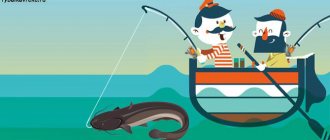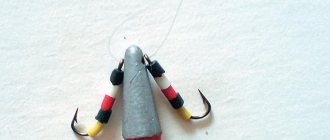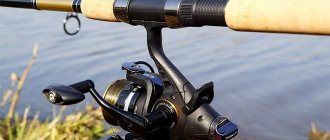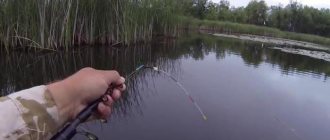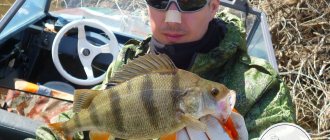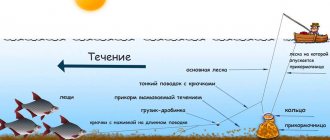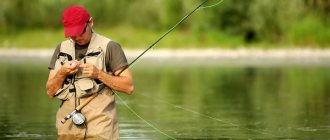Features of catfishing
Fishing for catfish is more successful if all its features and nuances are known (where, how, when and what to catch, how to feed correctly). Otherwise, you can simply waste time.
- Finding a catch spot. Catfish prefers warm fresh waters, so you should not look for it in the rivers of Siberia or other places with harsh climatic conditions. For its habitat, the predator chooses holes with a large amount of river debris, snags and silt, located near reservoirs, beds of large rivers and bridges. The more varied the terrain and the sharper the bottom changes, the greater the chances of encountering the coveted prey.
- When is the best time to catch? The animal is nocturnal, and in search of food is guided by the organs of touch (this function is most likely performed by the whiskers) and a well-developed sense of smell. It is better to start searching for a predator after the sun drops to the horizon. Catching catfish continues all night. At dawn, individuals who have lost their vigilance swim up to the coastal thickets of grass in search of a gaping frog, actively work their tails, making characteristic splashes, disturb the water and become most vulnerable to capture.
- Bait. The choice of bait depends on the time of year and its availability for the fisherman; catfish are omnivores and will be happy with any offer. Meat, large insects, crayfish and frogs are relevant in the autumn season , in the spring you can get by with leeches, dung worms collected in a bunch, live bait or dead fish (which is even preferable) of small size, bird giblets, and summer is not at all an inextricable source of attractive food. living creatures.
- Barley shells are a common food for catfish. Their sun-dried meat makes excellent bait. The exception is vegetable baits - the predator does not like them. When choosing bait, special emphasis should be placed on its smell - the brighter it is, the more attractive the bait is to a predator. It is easier for catfish to attack the bait if it is located at the bottom of the reservoir or directly above it.
- Lure. With bait it is much more difficult to guess. For this purpose, you can use a piece of turf with worms hidden in it. Most often, fish are attracted to a certain place by dropping food to the bottom several evenings in a row in the same place.
Donka for catfish with your own hands
Catfish is one of the largest fish in our reservoirs. Therefore, most fishermen are interested in catching such prey.
Large prey requires serious gear, otherwise you will be left without both. You also need to take with you a special and tasty bait. Such basic points are necessary for every fisherman who hunts catfish.
You can catch such a predator using a spinning rod, just a reel, or trolling with bottom gear. Since this article will focus on a DIY product, we will talk about the second option.
To build a fishing gear for catfish, we will need a rope or fishing line of special strength (0.5 - 1 mm in diameter), large size hooks No. 10-40 and a fairly heavy load.
The design is very simple. We tie a weight to the end of our cord, attach leashes above it (30-50 cm) and hook it all onto a carabiner to the main fishing line. That's the whole scheme.
You can use a piece of wood or foam as a coil. In this case, the cord is tied to some tree or bush on the shore. If you use a spinning rod (which is much more convenient for casting), then you need a large (4000 series) and reliable reel. It is important that the spinning rod itself is strong and rigid and can withstand heavy loads.
The beauty of homemade equipment is that it is designed specifically for trophy catfish. Store-bought inventory sometimes fails at the most inopportune moment.
Now let's analyze all the equipment elements in parts.
When mounting your own structure on a catfish, the role of fishing line is played by braided or twisted twine. Pay attention to the fact that it is thinner than the sting. As a rule, the maximum load of such a string is 30 -35 kg. You shouldn’t skimp on the length of your cord; take a generous margin of 50-100 m.
As for the weight that will hold our bait at the bottom, it can be bought ready-made, or it can be cast from lead in the form of a cylinder. Knit it at a distance of 50 - 90 cm from the hook. The weight of the weight depends on the body of water, on a river it is heavier 70-100 g, and in a regular body of water 40-50 g is enough. In order not to bother changing the weight on different bodies of water, you can install it on a clasp, or you can take several with you options for such equipment.
It is better to place one hook, but a large one. It can be made from thick wire (4-6 mm), or you can buy it in a store, which is much easier. We tie our “hook” through the hole where the notches are present.
That's basically all that needs to be said about this fishing gear. Now let's move on to some subtleties and baits.
Most often, catfish are caught at night, and in the morning they check their “traps”. This is due to the fact that it is at this time that the predator is actively hunting and scouring the bottom in search of food.
For greater efficiency and increasing the fishing area, it is prudent to throw several donks at different points. This way you will not only increase your chances, but also find out where the barbel most often hunts.
The results of spring and autumn catfish fishing are not particularly different, the only thing is that you need to change bait, that is, know when which one works better or worse. In the spring it goes well with a bunch of juicy worms.
So, we gradually came to the key point - what to fish for? Catfish tastes change with age. Accordingly, small individuals prefer small prey (crawlers, leeches or shells), the middle age category feeds on small fish, crayfish and frogs, and the oldest individuals are able to swallow large fish, aquatic birds, mice and even animals.
As you can see, the choice is very large and you can even use a piece of raw meat as bait. The catfish does not particularly go overboard with animal food, since it is a scavenger.
Fishermen quite often encounter another problem that arises on a new body of water. This is the right choice of fishing spot.
Catfish like to “rummage” in holes, where it is warm and cozy for them. It is very easy to understand where the ravine is. They are located at sharp turns of the river or near cliffs. The ideal option in your search would be to have an echo sounder, but not everyone has one. And if you do it the old fashioned way, you can visually quickly identify such a place.
It is very effective to fish areas at the entrance and exit of pits. If you hit it, then consider that you have found a gold mine. Also, you need to remember your places, because catfish usually do not change their hunting points and you can safely come here next time.
One night is enough for you to understand the location of the barbel, and then it’s just a matter of choosing the right bait. You can also try placing several “traps” near the shore, near reeds, water lilies or under trees.
As you can see, catching catfish with a donk is a little unusual and differs from traditional fishing for other objects. Homemade is always more reliable than purchased, and cheaper. Therefore, don’t be lazy and try to do something with your own hands, in the end you will be satisfied with the result.
som.rybalkanasha.ru
Basic requirements for gear for catching catfish
When going out to catch catfish, you should take reliable gear that can withstand a fairly high load, because the size and strength of a potential enemy cannot be predicted in advance. There are no trifles here, and any mistake can result in an offensive loss of loot.
- Rod. The rod must be powerful and suitable for continuous heavy loads. Fiberglass products meet this requirement. The optimal length of the rod should be about 3 m (with a longer length it will be difficult to control the fish in the last stages of fishing), the test is about 100-300 grams (for artificial baits - 100-150 grams).
- Coil. The main requirements for a reel are the capacity of the spool and increased strength of all its elements. It is preferable to use multiplier and inertia-free power reels with a spool capacity of at least 200 m. Reels used for carp fishing are quite suitable. In any case, the spool must be made of metal and have a perfectly smooth side without notches.
- Hooks. Hooks (homemade or factory made) made of high quality steel are used. Their appearance depends on the type of bait. A large hook (No. 8-10) with a short shank and an increased bend is used for a large bait, a smaller hook (No. 5-6) is combined with light bait (shell meat, worms, etc.) and is suitable for catching small fish.
- Braided cord. Instead of fishing line, catfish fishing uses a braided cord with a diameter of 0.35 to 0.7 mm. It can easily withstand a load of 30-60 kg. If you plan to fish for small catfish, you can be content with a fishing line with a diameter of 0.6-0.7 mm, which can withstand a load of about 25 kg.
- Leash. A Kevlar leash is best suited for catching catfish - it is flexible, tear-resistant (breaking load from 50 to 150 kg), binds well, is inextensible, and is protected from being bitten. If Kevlar leader material is not available, it can be replaced with thick fishing line with a diameter of at least 1 mm.
Line requirements
Choosing a fishing line is the most important stage in preparing for fishing. After all, the effectiveness of the entire process directly depends on its quality. To catch catfish, you need to choose fishing lines that have the following properties:
- high strength;
- low degree of elongation during landing;
- wear resistance.
You need to choose between braided cord and monofilament lines. At the same breaking load level, the diameter of a monofilament line is smaller than that of a braided cord. Accordingly, a larger piece of braid can fit on the spool.
The length of the fishing line plays an important role in the process of fishing for catfish. It is recommended to use sections of at least three hundred meters in length, since this large fish unwinds a significant amount of line during jerks. At the same time, monofilament is better able to “pacify” the jerks of large fish, and it also has fewer slippages during the final fishing.
It is recommended to choose a line with the maximum allowable diameter and breaking load, because you cannot predict what size prey will bite the bait. If these points are not foreseen in advance, the tackle that is not strong enough will break under the weight of large prey.
Spinning tackle for catching catfish
When catching big fish, spinning tackle experiences enormous loads. When choosing it, the emphasis is on power, reliability, functionality and shock-absorbing properties. First of all, this concerns the rod - it is chosen with a fast action, as strong as possible, long enough (2.7 -3 m) and with a test weight of at least 20-60 grams.
A braided cord is used as a fishing line. The optimal spool size for a power reel is 3000-5000. The length of the leash should be at least 30-40cm.
Depending on the type of spinning bait (jig-head, wobbler, spinner), there are several common methods of catching catfish:
Fishing with wobblers. Each wobbler has its own wiring horizon, which should be taken into account before starting fishing. The wobbler is driven evenly and slowly.
Jig fishing. Large silicone jig baits are suitable for catching catfish at great depths. The wiring of such baits can be stepped (when casting) or uniform (when trolling).
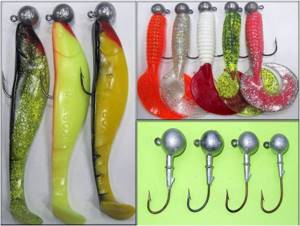
Lure fishing. Large, thick-walled spinners are used as bait. The spoon slowly drags along the bottom, raising muddy currents behind it and simulating moving prey.
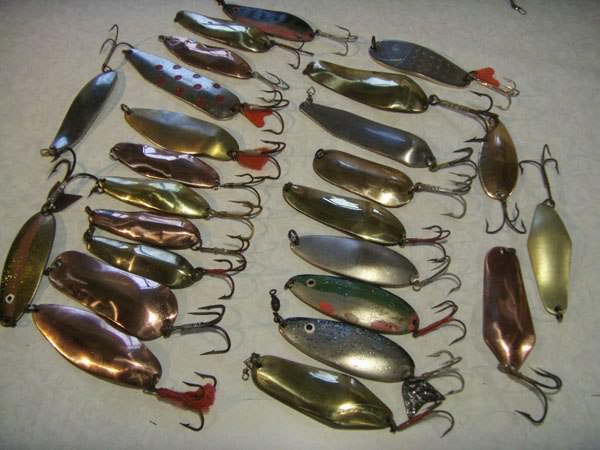
Features of fishing with spinning depending on the time of year:
- In the spring, when the water in the reservoir warms up to 10-120C, the life activity of the catfish is activated, and it leaves its wintering hole in search of prey. It is during this period that catfishing with a spinning rod begins. In search of a fishing spot, promising areas are examined - exits to shallow water from holes overgrown with silt and filled with snags, as well as secluded places under the rubble of bushes and trees, where the sun's rays practically do not reach. The fish, hungry during the winter, is ready to swallow any bait, and the main thing here is to use it correctly. At shallow depths, it is appropriate to use oscillating light spoons and wobblers, moving them evenly, slowly, without unnecessary jerks. Jig baits are well suited for deep water; they are cast in a stepwise manner, tapping the bottom in search of bottom fish.
- In summer, predators prefer to hunt from shelters - deep holes, recesses of washed-out banks, near dams and disperse throughout the entire reservoir. The best time to fish in hot weather is late evening or early morning. The most tempting baits are spoons and wobblers. Uniform wiring is appropriate here.
- In the fall, catfish are predictable, especially with the approach of the first frosts - they do not go far from their wintering grounds and feed intensively on the eve of hibernation, fattening up. Spinning fishing in the autumn is concentrated at great depths using large jig baits and large wobblers.
- In winter, spinners can rest - when the temperature drops to 70C, the predator goes into a wintering hole, where it goes into suspended animation and does not react to external stimuli.
TOP 5 forests
When choosing a suitable fishing line, also consider the strength of the fittings. It makes no sense to buy a fishing line stronger than the fittings themselves.
Let's look at the rating of the most popular lines for catching catfish, which are popular among professional fishermen.
It is recommended to choose from the following models:
- “ CatFish Mono Line ” - manufactured using European technologies using high-quality raw materials from Japan, is UV resistant;
- “ Black Cat Mon ” – material for making leashes;
- “ Black Cat Mono Leader ” – fishing lines of bright colors (yellow, orange);
- " Jaxson Crocodile " - high-strength fishing line, coated with fluorocarbon;
- “ Special + Com ” – the material is abrasion resistant, high strength, minimal elongation.
Article on the topic: Catching catfish with kwok
It is worth remembering the balance of the gear. It is necessary to choose a fishing line depending on the characteristics of the fishing rod - the softer the blank, the stiffer the fishing line will be required, and vice versa.
Bottom tackle for catching catfish
This type of catfish fishing is most productive at dusk and at night. Most often they resort to it when other methods of fishing are out of the question - the impressive depth of the reservoir, the presence of whirlpools, a powerful current at river turns, a long wait time for a bite.
Bottom tackle must have special power, because great depths are famous for giant specimens of predatory fish. Therefore, you should choose a very strong rod with a large margin of safety and the highest possible test.
It is better to choose a multiplier reel with a large-capacity spool made of metal. The optimal diameter of the fishing line is 0.5 – 1 mm. The leash is made of durable cord.
When it comes to hooks, you shouldn’t skimp – you should opt for products made of high-quality material, sharp, durable and large (starting from No. 10). Hooks must match the type of bait and the weight of the intended fish.
The tackle is equipped with a sliding type of sinker, which allows you to adjust the level of immersion of the bait.
Bottom fishing is a long process that can take up to several days. Therefore, when going fishing, you need to stock up on provisions, drinking water, a change of clothes and, of course, endurance.
Independent production of bottom gear. To make your own gear you will need the following materials:
- A strong main line with a diameter of 0.5 - 1 mm (can be replaced with a braided cord) and a length of 200 m or more.
- Nylon cord with a diameter of 1 mm and a length of about 75 cm (used to make a leash).
- A weight weighing from 60 to 100 g (sometimes it becomes necessary to use several weights at once).
- Hooks No. 10-No. 40 (the choice of size depends on the size of the expected catch).
- Swivels.
- Carbine.

Assembling the device is not particularly difficult and is performed in the following sequence:
- A leash made of nylon cord approximately 75 cm long is tied on one side with a fisherman's knot to a hook, and on the other to a swivel (the turns of the cord should lie one after the other, without overlapping, it is better to burn the joint edges of the cord);
- On the other side of the swivel, a nylon thread 40-50 cm long is tied, onto which a sinker is strung (weights for catching catfish, despite the impressive weight of 60-100 g, look compact and can easily slide along the thread, the choice of weight depends on the speed of the current and bait weight);
- The gear prepared in this way is tied to a carabiner;
- The carabiner is connected via a swivel to the main line (when catching catfish from the shore) or to a cord with a cross-section of 3 mm or more (when catching a predator from a boat).
Setting up bottom gear for catfish for fishing from the shore
Equipment for catching catfish from shorelines can be assembled on the basis of two concepts, one of which is based on the mounting kit on the rod, and the second on the reel. The gear assembled on a fishing rod is similar to the design of a hook or feeder, where the main role of the process of supplying bait and retrieving the hooked trophy is assigned to the parameters of the rod and spinning reel for catching catfish. Rigs assembled on reels and cords are completely identical to the classic types of bottom tackle, elastic bottoms or nets. The composition of such equipment for catfish includes the possibility of using a variety of leashes, giving the angler the variability of using different types of baits, as a result of which it is possible to select the promising bait that can be used most successfully during the fishing session.
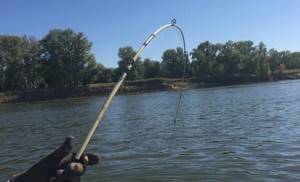
If the use of equipment on rods often limits the fishing distance to the maximum casting capabilities, then the use of donks on cords can cover large water areas, allowing fishing at different horizons in the water column. It is worth noting that coastal installation will require competent selection and preparation of a fishing spot on the coastline, ensuring comfortable casting of equipment and unhindered retrieval of the caught trophy, bringing it to the shallows, followed by fishing and pulling directly to the shore itself.
Types of bottom gear
The design of bottom tackle for catfish is not limited to mounting on a fishing rod and the classic type of corded bottom tackle. This giant can be successfully caught using a girder or a suspended bait. The structure of the catfish trap does not differ from the well-known pike trap assembled on a flyer. The main difference between the gear is the greater thickness of the fishing line used and the massive, durable hook. Otherwise, fishing tackle is similar in principle to pike fishing tactics. The zherlitsa is placed on the shore, attached to a pole or a suitable bush. After supplying the bait to a promising fishing point, the fishing line is inserted into the guard slot and monitored for the presence of a winding of the cord indicating that a bite has occurred.

The suspension is even simpler in its design. You can make a tackle for catfish from a piece of braided cord, a sliding sinker and a hook. The equipment brought into the fishing zone is attached to a tree branch hanging over the water or a coastal snag sticking out of the water through a rubber shock absorber, which allows you to hold the caught fish on the hook without breaking the cord. As a rule, the length of the fishing line does not exceed 8–10 meters and is used as sharpened gear in coastal areas known for the constant presence of the predator. In continuation of the article, we will focus on a more specific description of the assembly of the hook and the manufacture of rubber donkeys, which somyatniks consider universal tools for coastal fishing for mustachioed predators.
Making equipment for catfish
Catfish fishing rods should be particularly reliable material with average test parameters. A test level of 70–100 grams will ensure delivery of any type of bait to the fishing zone. The length of the chosen rod is 3-3.5 meters, allowing you to make long casts. The average and even soft action of the fishing rod will give you confidence when fishing, absorbing strong jerks of the fish while pumping out. A reel for catfish in a reel is more practical, inertia-free, with high traction characteristics and a large spool. The device must be made of metal alloys, including the working mechanism itself. This feature allows you to achieve the necessary strength qualities, albeit sometimes at the expense of the lightness of the accessory, and indeed the entire gear. The size of a spinning rod of 4500–5000 units is the most suitable type for this type of bottom fishing. The main cord is selected from braided fishing line with a diameter of 0.4 mm, equipped with a sliding weight and a single hook.
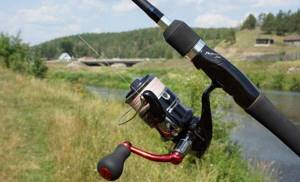
The elastic band is assembled on a braided cord with a thickness of 0.7 mm. The cord is stored on a wooden reel, which can accommodate a line volume of 200–250 meters. For the tackle you will need a sinker weighing 3–5 kg, which is attached to the cord base through a shock-absorbing elastic band of at least 1.5–2 mm in diameter. Fishing at such long distances requires a model 40–50 meters long.
The installation of an additional shock absorber, which is installed at the point where the donkey is connected to the support on the shore, will help to make a catfish donk reliably and correctly. A rubber tourniquet is tied into a meter-long loop bent on the cord, thus completely protecting the equipment from breakage even by the largest fish. On the cord itself, loops are made through the distance required by the fishing conditions, into which half-meter braided leashes with a diameter of 0.2-0.3 mm are attached. As a rule, for high-quality fishing, there must be at least five hooks.
Important! Keeping the bait in the desired water level is achieved by installing foam floats or sliding weights on the leash.
To install a rubber donkey on a pond, a floating device is required, through which the cargo is delivered to the anchoring point of the tackle.
Features of installation and fishing
You can successfully catch catfish from the shore using bottom tackle, especially at night. The main thing here is to guess the fishing spot and correctly calculate the casting distance of the bait (they must match). The bait can be delivered to the chosen place by boat, and then returned to the shore and calmly wait for a bite.
Donks without a rod are secured to the shore with powerful stakes, firmly driven into the ground, or tied to trees. If the bottom tackle is attached to a fishing rod, it is installed in a special stand, securely screwed into the soil.
When fishing from a boat, use short rods or simply hold the tackle in your hands. The rods are firmly fixed on holders to the side of the boat and the line tension is adjusted as necessary.
If you choose the method of holding the tackle in your hands without a rod, the following precautions should be observed:
- You cannot wrap the cord (line) around your hand - with a strong tug, you can fall out of the boat or even lose your hand.
- You should move carefully along the bottom of the boat and try not to get your feet entangled in loose tackle - you should always have a sharp cutting object at hand that can quickly cut the cord.
It is dangerous to drag large prey into a boat (the predator has immense strength and is quite capable of turning over a small boat).
Baits are placed on the sides of the holes and on their bottom. The bait is no different from the bait when catching catfish using another method - larvae, worms, crayfish, fish and meat are not the freshest. You should behave quietly while fishing so as not to scare away the fish with extraneous sounds.
Trolling gear and fishing techniques
Trolling catfish is one of the most effective ways to catch a predator, but also the most difficult of all. It is carried out from a boat (inflatable or hull), equipped with a motor and in constant motion. Well suited for catching catfish in rivers and other open waters all year round.
Particular effectiveness can be achieved in the summer. The time of day does not affect the capture of prey - with the correct organization of the process, fishing goes well during the day, at night and in the evening. An echo sounder and navigator provide invaluable assistance to a fisherman in searching for prey at great depths and expanses. The latter device also helps determine the speed of the boat.
Tackle
- The boat must be safe, spacious, stable, well controlled and equipped with a powerful motor.
- A fishing rod is selected that is powerful, made of composite materials, with a medium action blank, a plug-in design, a cast of 100 g or more, a screw-type reel holder and reinforced rings. The optimal length is 2.4 – 2.8 m.
- The type of reel (multiplier or spinning) depends on the preferences of the fisherman and does not affect the quality of fishing. Of the general requirements, pay attention to the following points: strength, spool capacity (250 m or more), size (3000-5000), ease of rotation, quality of line laying and speed of spool replacement.
- Braided fishing line with a cross section of 0.3 -0.35 mm.
- A long leash in the form of a braided metal cable.
Lures
In most cases, bladed wobblers with different immersion horizons are used as bait. It is worth choosing wobblers designed specifically for trolling fishing - they are capable of operating at high speeds of about 3-7 km/h, are not thrown to the surface, and do not twist when moving.
Some fishermen try to experiment with large silicone baits and spinners, but they are more difficult to keep in the intended horizon of fish presence. Since catfish do not have good eyesight, the color of the bait will not play a special role.
Fishing technique
If the bottom topography and the depth of the reservoir are known, the rod is attached to a holder on the boat, a wobbler of the required parameters is installed, thrown into the water and begins to move against the current along a pre-planned course.
In situations where the reservoir is little known or the bottom has sharp changes, it is better to hold the rod in your hands in order to react in time with a sharp jerk when the wobbler catches on a snag.
The new, previously untested wobbler model also needs increased attention from the fisherman - the rod is held suspended in order to feel the sound of the wobbler with a shovel on the bottom with your hand and determine the true depth of the nozzle.
Other types of gear and fishing methods
In addition to the popular methods of catching catfish, there are other, no less popular options:
Fishing with homemade gear
Having a large hook made of high-quality steel, a line and a sinker, you can prepare and assemble the equipment with your own hands. To make a hook, use steel wire with a cross section of 5-6 mm. The hole (a round bend at one end of the product) into which the cord will be inserted is equipped with notches along its entire length.
When choosing a cord, you should pay attention to its thickness (it should not be greater than the diameter of the wire from which the hook is made), strength (breaking load of at least 30 kg) and length (no more than 100 m). The cord can be made of strong fishing line or linen or hemp rope.
The reel for storing the cord is cut out of polystyrene foam or wood , burrs, sharp corners, and other possible defects are carefully removed and, for convenience, attached to a metal axle with a handle.
The sinker can be cast from tin or lead yourself, achieving the shape of a hollow cylinder, or you can purchase it ready-made in the store. The weight of the sinker and its size are directly dependent on the thickness of the cord, the dimensions of the nozzle and the speed of the current in the reservoir. The finished product is attached to the cord motionlessly at a distance of 70-100 cm from the hook.
The assembly of the structure is carried out according to the same principle as state gear. The reel is attached to the rod, the main line is passed through the rings, brought to the desired length and connected to the leash through a carabiner. Hooks and sinkers are already attached to it.
Fishing with lines
Fishing tackle when catching catfish with slings differs from standard tackle in the number of hooks used - there are significantly more of them. Therefore, the use of this fishing method in some regions may be limited by the number of hooks, the time of year, or even prohibited (considered as poaching). Before deciding on this type of fishing, it is better to clarify all the legal issues in advance so as not to get into an unpleasant situation.
The main line of the line, one end of which is tied to the load, and the other is attached to the shore, is stretched in the water column at the bottom. For this type of tackle, a fishing line with a cross-section of 0.6-0.8 mm (you can use a nylon cord) with a length of 30 to 40 m is selected. The first loop on the fishing line, to which the leash with a hook is attached, is made at a distance of 70 - 100 cm from the load. The number of loops, and therefore leashes with hooks, can vary. Leashes 40–60 cm long are cut from thick fishing line or Kevlar thread.
Sinkers for catfish
The requirements for catfish sinkers are quite specific and depend on two things:
- - current speed at the fishing site;
- - the size of the bait used.
With a small and light bait, for example, barley meat or a bunch of worms, and a small weak current, light weights weighing 60 grams or more are used for such tackle. In stores in Kyiv, Dnepropetrovsk or Kharkov there is a large selection of sinkers suitable for catching catfish. For large, live, heavy and voluminous bait, and strong currents, use heavy loads weighing 400 grams or more. For example, to catch large catfish on the Dnieper and Desna using large half-kilogram live bait, bags filled with stones weighing about 5-8 kg are used. It is impossible to throw such loads, so they are transported by boat to the fishing site or lowered from bridges into the water.
Features of catching catfish with kwok
One of the most ancient methods of catching catfish is kwok fishing. This is a classic of the genre and consists of luring the fish to the boat with rhythmic strikes on the water (5-6 strikes with a pause of half a minute) with a special curved stick - kwok. The design of the quok is simple and consists of a handle, a cutwater (knife) and a heel (hoof). It is made from various materials - plastic, wood, metal.
The smacking sound made by the device when struck on the surface of the water forces the catfish to leave its shelter and rise from the depths. The phenomenon of this action has not yet been solved, but its effectiveness has long been proven.
To catch a predator using a quok, simple gear is required: a high-strength fishing line wound on a reel or reel made of wood, a meter-long leash with a diameter of 0.5 - 0.8 mm, a sinker of the required weight and a strong hook of a large size.
Such traditional dishes as large insect larvae, a bunch of worms, a frog, small fish, in general, everything that catfish are so partial to are quite suitable as bait.
The bait should be under the boat . It is better to fish with quok over holes. You should choose a boat that is quiet and inconspicuous. Catching catfish by nodding makes it much easier to have an echo sounder.
Cord Requirements
When fishing for kwok, cords are used. A high-quality catfish cord has almost zero elongation and high strength under dynamic loads. A sufficiently slippery surface of the tackle will ensure the ability to throw the hook at the maximum distance.
Since catfish is a predatory fish, you will need a cord with increased abrasion resistance and durability. Bait plays an important role in fishing. Therefore, it is recommended to choose softer cords that will ensure a subtle play of the bait, which will attract prey.
Blitz - tips
- You can count on a good bite in the evening, at night and early in the morning. When looking for a predator, it is better to go closer to the shore, where under the cover of darkness it prowls in search of frogs, crayfish and shells.
- Medium depths and washed-out shores are an ideal place for catching catfish during the daytime.
- In slow-flowing waters, bait should be cast upstream from the location of the intended prey.
- When choosing bait, you need to focus on the attractiveness of the smell, not the color (catfish are almost completely blind, but have a well-developed sense of smell).
Kwok for catfish
Kwok is an amazing device that allows you to attract catfish to the bait. It has been used in catfishing in Europe for several thousand years. It is something between a curved handle of a shovel and a crutch with a thickened heel at the end. Used in onboard bottom fishing. A fisherman on a boat swims up to the catfish hole, stands above it and lowers the side bottom tackle with bait into the right place. And then he immerses the quok in the water in a certain way, as if rowing it. Kwok makes a croaking sound “Kwo-o-ok, kwo-o-ok”, which attracts the catfish to the bait. There are many speculations as to why this happens, but there is no single explanation. Previously, quoks were made only from wood and only by single craftsmen. It was difficult to make the correct quok. Nowadays, buying a quok for catching catfish in Ukraine is not difficult. Prices for quoks are relatively affordable, and quoks are not consumables. Having bought it once and gotten used to working with it, the fisherman will not be able to exchange it for something else. The industry has mastered the production of quoks made of wood, metal, glass and carbon fiber. As ancient as the boomerang, the kwok requires the same skill in handling it as the boomerang. Therefore, an angler should practice in the bathroom before going fishing. There are many video tutorials on the Internet that allow you to learn how to work with a kwok.
